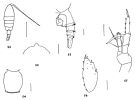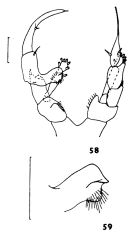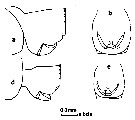|
|
 |
|
Calanoida ( Order ) |
|
|
|
Arietelloidea ( Superfamily ) |
|
|
|
Heterorhabdidae ( Family ) |
|
|
|
Heterorhabdus ( Genus ) |
|
|
| |
Heterorhabdus lobatus Bradford, 1971 (F,M) | |
| | | | | | | Syn.: | Heterorhabdus papilliger : Bradford, 1970 a (p.358, figs.F,M, Rem); 1972 (p.46, figs.F);
Heterorhabdus (Heterorhabdus) lobatus : Bradford-Grieve,1999 b (p.81, figs.F,M, Rem., figs.174, 191) | | | | Ref.: | | | Bradford, 1971 a (p.131, figs.F,M); Bradford-Grieve & al., 1999 (p.883, 944, figs.F,M); Park, 2000 (p.105, figs.F,M, Rem.) |  issued from : T. Park in Bull. Scripps Inst. Oceanogr. Univ. California, San Diego, 2000, 31. [p.226, Fig.74]. Female: a, b, urosome (dorsal, left, respectively); c, genital somite with posteroventral arthrodial membrane folded in (left); d, genital somite with posteroventral arthrodial membrane somewhat extended (left). Male: e, P5 (anterior); f, left P5 (endopod omitted), anterior; g, basipod of right P5 (anterior); h, i, second exopodal segment of right P5 (anterior, posterior, respectively); j, k, second exopodal segment of right P5 from different specimen (anterior, posterior, respectively).
|
 issued from : J.M. Bradford-Grieve in The Marine Fauna of New Zealand: Pelagic Calanoid Copepoda. National Institute of Water and Atmospheric Research (NIWA). NIWA Biodiversity Memoir, 111, 1999. [p.81, Fig.48]. Female: A, genital somite (right lateral side); B, idem (dorsal); C, genital somite (right lateral side); D, exopod segment 3 of P5; E, endopod of P5; F, Mxp. Male: G, P5.
|
 issued from : J.M. Bradford in N.Z. Jl Mar. Freshw. Res., 1970, 4 (4). [p.359, Figs 52-57]. Female (off Kaikoura, New Zealand): 52, habitus (dorsal); 53, forehead (dorsal); 54, genital segment dorsal); 55, urosome (lateral left side); 56, 3rd exopod of P3; 57, P5. ( Scale bars represent 0.1 mm.
|
 issued from : J.M. Bradford in N.Z. Jl Mar. Freshw. Res., 1970, 4 (4). [p359., Figs 58-59]. Male (off Kaikoura, New Zealand): 58, P5; 59, internal protrusion on 2nd exopod of right P5 (this protrusion bears a serrated projection). Scale bars represent 0.1 mm.
|
 issued from : J.M. Bradford in Mem. N. Z. Oceonogr. Inst., 1972, 54. [p.47, Fig.12, (7-12]. As Heterorhabdus papilliger. Female (from Kaikoura, New Zealand): 7, habitus (dorsal); 8, Mx2; 9, P5; 10, P3 (exopod segment 3); 11, urosome (lateral);12, Mxp. Scale bars: 1 mm (7); 0.1 mm (8-12).
|
 issued from : J.M. Bradford in N.Z. Jl mar. freshw. Res., 1971, 5 (1). [p.132, Fig.10, a, b, d, e): Comparison between H. lobatus (a, b) and H. papilliger (d, e) females. a, d: genital segment (left side); b, e: ventral view of genital segment.
|
 issued from : J.M. Bradford in N.Z. Jl mar. freshw. Res., 1971, 5 (1). [p.132, Fig.10, a, b, d, e): Comparison between H. lobatus (c) and H. papilliger (f) males. c, f: P5.
|
 Heterorhabdus lobatus Heterorhabdus lobatus female: 1 - See key to species groups of Heterorhabdus: ''papilliger'' Group (p.90, 102). 2 - Midanterior tubercular process of forehead produced into a rounded process and not produced into a spiniform process. P5 without inner marginal seta on 1st endopodal segment. 3 - Laterally, genital prominence extending down to posterior end of somite (Fig.74-b). 4 - Laterally, genital prominence somewhat truncate, with a steep anterior wall making an angle of about 75° with longitudinal axis of somite (Fig.74-b).
|
 Heterorhabdus lobatus Heterorhabdus lobatus male: 1 - See key to species groups of Heterorhabdus: ''papilliger'' Group (p.90, 102). 2 - Medianterior tubercular process of forehead angular and not produced into a spiniform process. Basal inner lobe of left P5 rather poorly developed with angular distally (Fig.74-f). 3 - In right P5, medial projection of 2nd exopodal segment terminally expanded, with a large, rounded lobe (Fig.74-h). 4 - In medial projection of 2nd exopodal segment of right P5, distal lobe more or less rounded and similar in size to proximal lobe (Fig.74-k).
|
 issued from : J.M. Bradford in N.Z. Jl mar. freshw. Res., 1971, 5 (1). [p.133, Table 2): Differences between H. lobatus and H. papilliger.
| | | | | Compl. Ref.: | | | Carter, 1977 (1978) (p.36); Ayon & al., 2008 (p.238, Table 4: Peruvian samples); Park & Ferrari, 2009 (p.143, Table 5, Appendix 1, biogeography); Schnack-Schiel & al., 2010 (p.2064, Table 2: E Atlantic subtropical/tropical); Hidalgo & al., 2010 (p.2089, Table 2); Hidalgo & al., 2012 (p.134, Table 2) | | | | NZ: | 8 | | |
|
Distribution map of Heterorhabdus lobatus by geographical zones
|
| | | | | |  Chart of 1996 Chart of 1996 | |
| | | | Loc: | | | South Afica. (E & W), Namibia (in Carola, 1994), SE Atlant., off Mauritania- NW Cape Verde Is. (in Lapernat, 2000, tab.3, 4), South Africa (Natal), S Mozambique, SW Indian, E Pacif. (N-S), Pacif. ( E equatorial), Peru, New Zealand (N & S, Kaikoura), sub-Antarct., Tasman Sea (N & S), Chile (N-S, off Santiago)
Type locality: 42°24.5'S, 174°01.8'E. | | | | N: | 8 | | | | Lg.: | | | (116) F: 2,5; (399) F: 2,6-2,1; M: 2,5-2; (824) F: 2,64-2; M: 2,76-1,92; {F: 2,00-2,64; M: 1,92-2,76} | | | | Rem.: | "Papilliger" Group.
epi-mesopelagic.
After Park (2000, p.105) this species is similar in habitus to H. guineanensis and H. papilliger.
This species is closely related to H. papilliger. Confusions can exist between this species and H. papilliger.
First occurrence in Chilean waters by Hidalgo & al. (2010). | | | Last update : 22/09/2015 | |
|
|
 Any use of this site for a publication will be mentioned with the following reference : Any use of this site for a publication will be mentioned with the following reference :
Razouls C., Desreumaux N., Kouwenberg J. and de Bovée F., 2005-2025. - Biodiversity of Marine Planktonic Copepods (morphology, geographical distribution and biological data). Sorbonne University, CNRS. Available at http://copepodes.obs-banyuls.fr/en [Accessed October 20, 2025] © copyright 2005-2025 Sorbonne University, CNRS
|
|
 |
 |










